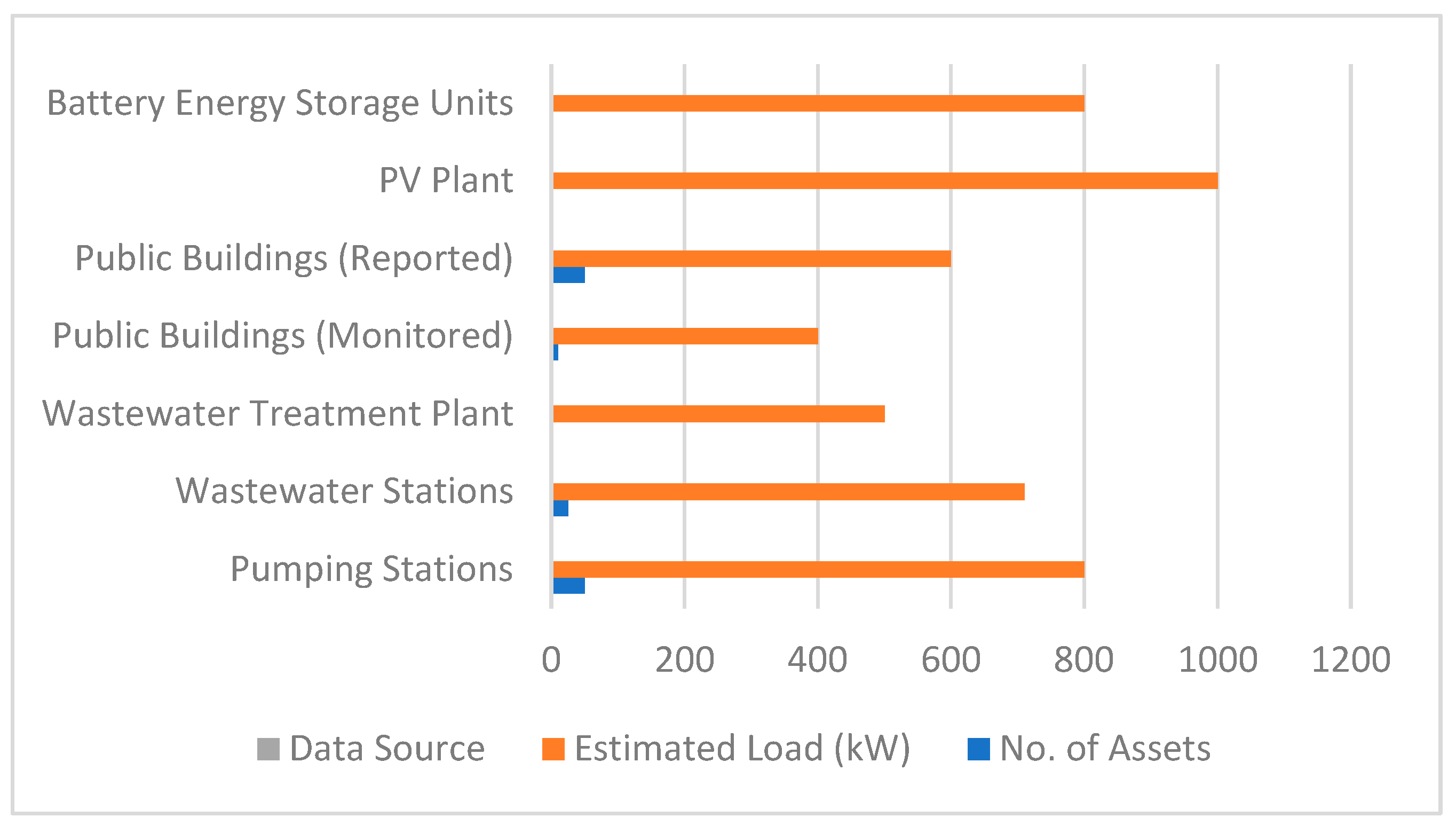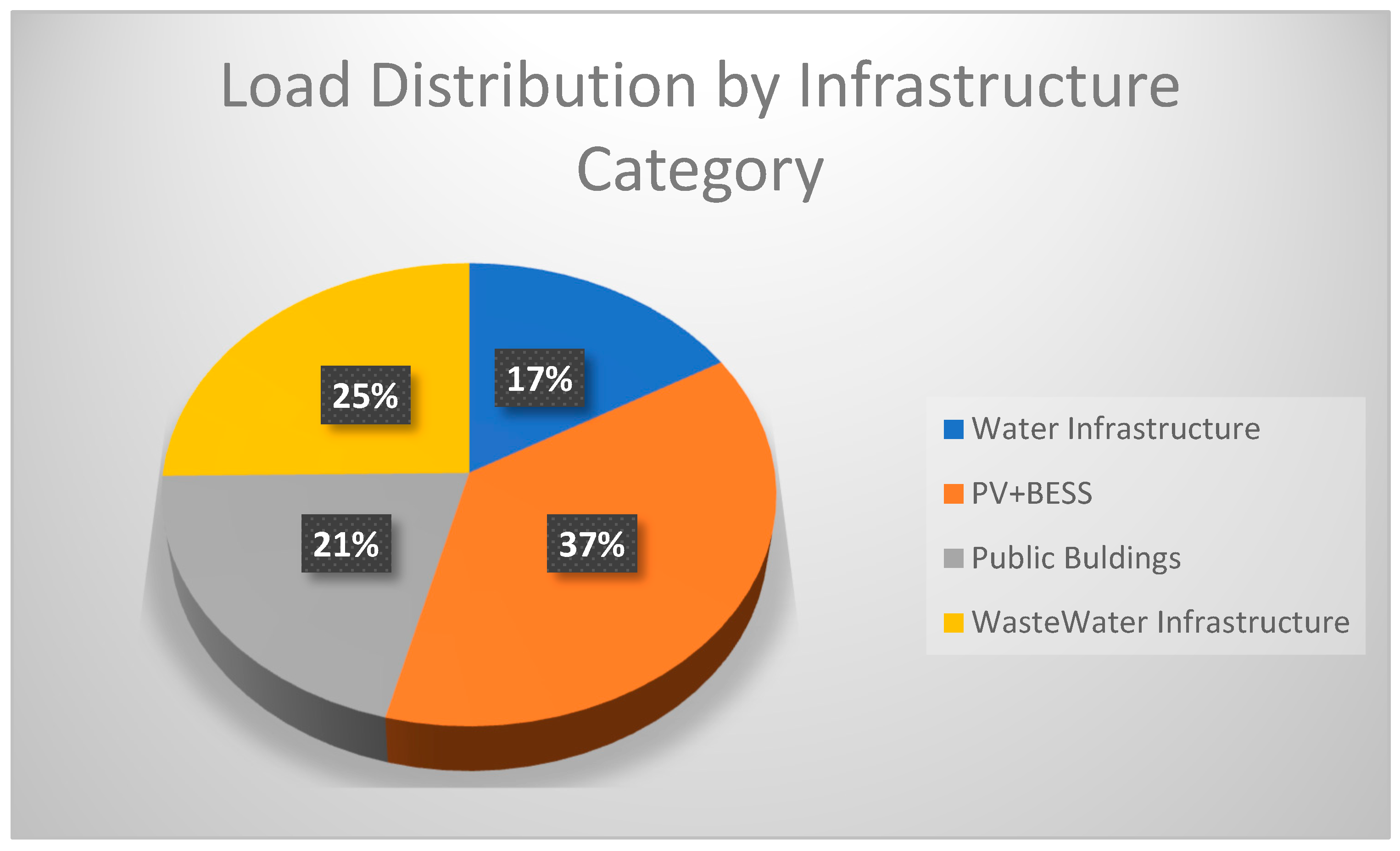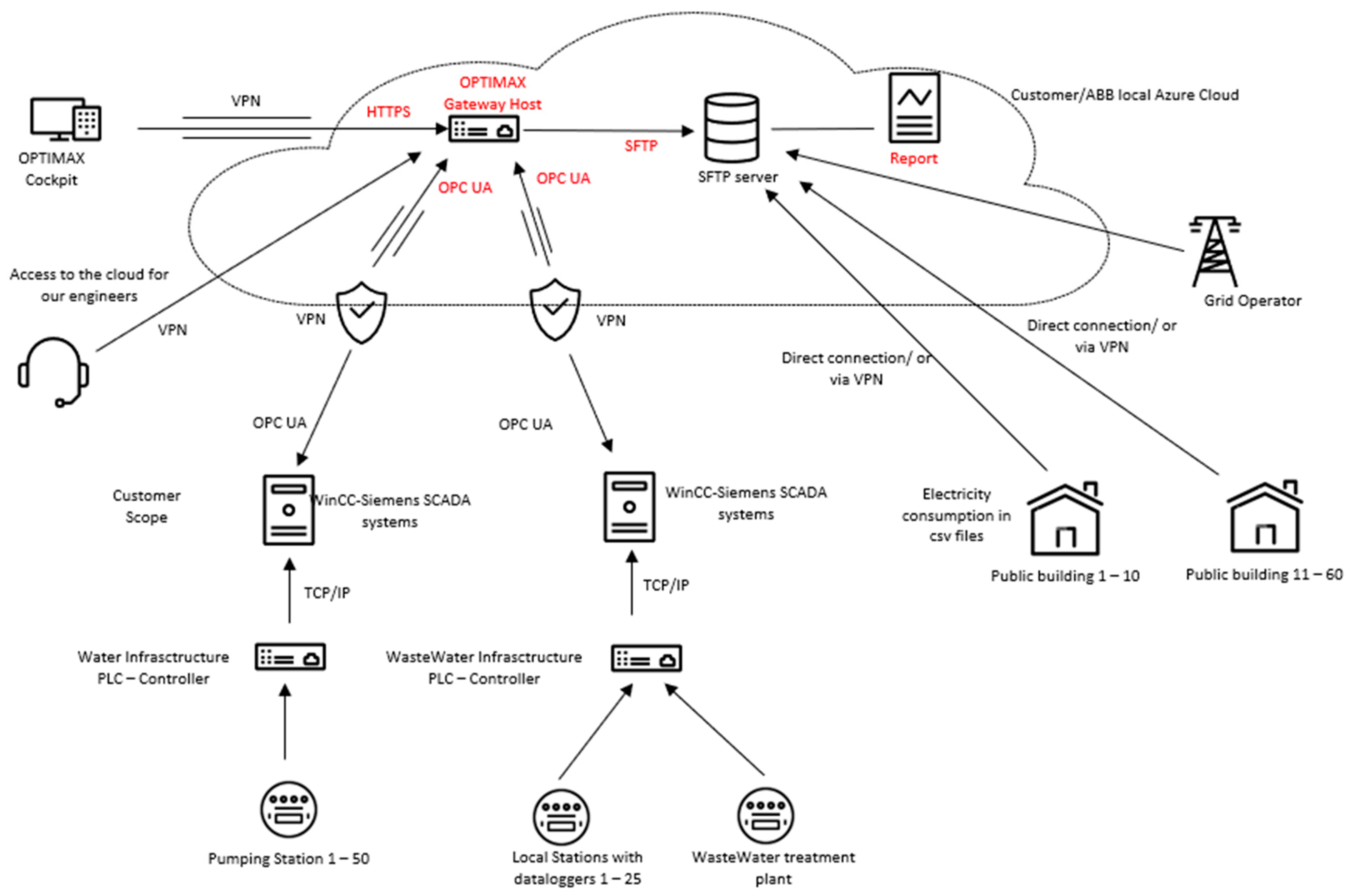AI-Based Energy Management and Optimization for Urban Infrastructure: A Case Study in Trikala, Greece †
Abstract
1. Introduction
2. Material and Methods
2.1. System Architecture
- Water and Wastewater Infrastructure: Including 50 pumping stations and 25 local stations with dataloggers, plus one wastewater treatment plant (WWTP), accounting for a combined load of ~2 MW.
- Public Buildings: A set of 60 buildings, of which 10 will be fully monitored (energy consumption and analytics) and 50 will be reported through periodic CSV file uploads.
- Renewable Assets: A 1 MWp photovoltaic plant and two Battery Energy Storage Systems (BESS) will be included in the future, forming the distributed energy resources (DER) layer.
2.2. Data Integration and Signal Design
- Load forecasting (using historical consumption and weather data)
- Intra-day dispatch optimization
- Day-ahead planning based on price signals (when available) and PV forecasts
- Anomaly detection and efficiency diagnostics
2.3. AI-Driven Forecasting and Optimization
3. Expected Results
3.1. Load Coverage and System Responsiveness
3.2. Forecasting Accuracy and Optimization Potential
3.3. Energy Flow Optimization Scenarios
- PV self-consumption ratios could be increased by 22% by rescheduling pumping operations to daylight hours.
- Energy cost savings for public buildings (when simulated against time-of-use pricing) ranged from 12% to 18%.
- Load balancing between BESS and grid could import reduced peak loads by approximately 15% in modeled weeks.
4. Discussion—Ongoing Work
4.1. Final Integration and Live Testing
4.2. Energy Policy and Governance Interfaces
4.3. Scalability and Replication
4.4. AI Governance and Ethical Considerations
4.5. Future Research Directions
- Incorporating dynamic pricing algorithms for BESS operation optimization
- Enhancing digital twin fidelity to better simulate fault scenarios
- Exploring federated learning for cross-municipality AI model sharing
- Evaluating citizen behavior modeling to inform DSM strategies
Author Contributions
Funding
Institutional Review Board Statement
Informed Consent Statement
Data Availability Statement
Acknowledgments
Conflicts of Interest
References
- Omitaomu, O.A.; Niu, H. Artificial Intelligence Techniques in Smart Grid: A Survey. Smart Cities 2021, 4, 548–568. [Google Scholar] [CrossRef]
- Zhou, K.; Fu, C.; Yang, S. Big data driven smart energy management: From big data to big insights. Renew. Sustain. Energy Rev. 2016, 56, 215–225. [Google Scholar] [CrossRef]
- Moran, P.; O’COnnell, J.; Goggins, J. Sustainable energy efficiency retrofits as residenial buildings move towards nearly zero energy building (NZEB) standards. Energy Build. 2020, 211, 109816. [Google Scholar] [CrossRef]
- Sarmas, E.; Marinakis, V.; Doukas, H. Future Directions of Intelligent Energy Management and the Role of Generative AI. In Artificial Intelligence for Energy Systems. Learning and Analytics in Intelligent Systems; Springer: Cham, Switzerland, 2025; Volume 46. [Google Scholar] [CrossRef]
- Sarmas, E.; Marinakis, V.; Doukas, H. Meta-Learning Approaches for Assessing Energy Efficiency Investments in Buildings. In Artificial Intelligence for Energy Systems. Learning and Analytics in Intelligent Systems; Springer: Cham, Switzerland, 2025; Volume 46. [Google Scholar] [CrossRef]
- Michalakopoulos, V.; Sarmas, E.; Papias, I.; Skaloumpakas, P.; Marinakis, V.; Doukas, H. A machine learning-based framework for clustering residential electricity load profiles to enhance demand response programs. Appl. Energy 2024, 361, 122943. [Google Scholar] [CrossRef]
- Kanellou, E.; Sarri, M.; Zoumpoulaki, K.; Koasidis, K.; Marinakis, V.; Doukas, H.; Nikas, A. ESG Criteria in Investment Decision Making: Trends and Perspectives. In Proceedings of the 2024 15th International Conference on Information, Intelligence, Systems & Applications (IISA), Chania, Crete, Greece, 17–19 July 2024; pp. 1–7. [Google Scholar] [CrossRef]
- Sarmas, E.; Marinakis, V.; Doukas, H. Correction: A data-driven multicriteria decision making tool for assessing investments in energy efficiency. Oper. Res. 2023, 23, 21. [Google Scholar] [CrossRef]




Disclaimer/Publisher’s Note: The statements, opinions and data contained in all publications are solely those of the individual author(s) and contributor(s) and not of MDPI and/or the editor(s). MDPI and/or the editor(s) disclaim responsibility for any injury to people or property resulting from any ideas, methods, instructions or products referred to in the content. |
© 2025 by the authors. Licensee MDPI, Basel, Switzerland. This article is an open access article distributed under the terms and conditions of the Creative Commons Attribution (CC BY) license (https://creativecommons.org/licenses/by/4.0/).
Share and Cite
Chasiotis, A.; Gialama, S.; Piromalis, D.; Nastos, P.T. AI-Based Energy Management and Optimization for Urban Infrastructure: A Case Study in Trikala, Greece. Environ. Earth Sci. Proc. 2025, 35, 76. https://doi.org/10.3390/eesp2025035076
Chasiotis A, Gialama S, Piromalis D, Nastos PT. AI-Based Energy Management and Optimization for Urban Infrastructure: A Case Study in Trikala, Greece. Environmental and Earth Sciences Proceedings. 2025; 35(1):76. https://doi.org/10.3390/eesp2025035076
Chicago/Turabian StyleChasiotis, Angelos, Sofia Gialama, Dimitris Piromalis, and Panagiotis T. Nastos. 2025. "AI-Based Energy Management and Optimization for Urban Infrastructure: A Case Study in Trikala, Greece" Environmental and Earth Sciences Proceedings 35, no. 1: 76. https://doi.org/10.3390/eesp2025035076
APA StyleChasiotis, A., Gialama, S., Piromalis, D., & Nastos, P. T. (2025). AI-Based Energy Management and Optimization for Urban Infrastructure: A Case Study in Trikala, Greece. Environmental and Earth Sciences Proceedings, 35(1), 76. https://doi.org/10.3390/eesp2025035076







